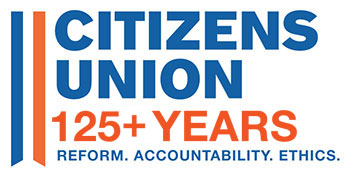FOR IMMEDIATE RELEASE
July 19, 2021
Contact: Jake Oliver, jake@anatgerstein.com, (347) 361-9983
Analysis shows Ranked Choice Voting gave more voters a say in elections with fewer “wasted” votes, encouraged more women to run for office, and helped more women and people of color win, with benefits seen in all five boroughs
To view Citizens Union’s analysis, click here
New York, N.Y. (July 19, 2021)— Today, Citizens Union released a detailed analysis of the June primary elections in New York City, examining the impact of Ranked Choice Voting. The analysis found that Ranked Choice Voting gave more voters a say in elections, with fewer votes “wasted” on candidates who fell well short of winning their races. The analysis also found that voter turnout increased; voters embraced Ranked Choice Voting and navigated the system well; and the number of women running, and the number of women and people of color winning increased. These benefits were seen throughout the city.
“This election marked the first time Ranked Choice Voting was widely used in New York City, and the results were overwhelmingly positive,” said Betsy Gotbaum, Executive Director of Citizens Union. “New Yorkers enthusiastically embraced Ranked Choice Voting and easily navigated the new system. It gave more voters a say in who runs our city, helped drive up voter turnout, led to a more diverse pool of candidates, and helped more women and people of color win. The concerns expressed by opponents of this reform were largely unfounded.”
Below is an outline of some of the key findings of Citizens Union’s analysis:
-
The number of “wasted” votes decreased significantly in all levels: Using Ranked Choice Voting, New Yorkers were able to have more say in the result of elections and to avoid having their vote “wasted” on candidates who were less popular with voters overall. For example, in the Democratic mayoral primary of 2013, more than 228,600 people – or 33% of voters – cast their ballots for candidates who were not among the top two vote-getters. In 2021, only 139,459 voters – or 14.9% – had “inactive ballots” in the final round of Ranked Choice Voting. A sharp decrease in “wasted” ballots is observed in almost every race.
-
The number of female candidates almost tripled: Under Ranked Choice Voting, 152 women ran for city offices, compared to 52 female candidates in 2013. The difference is even bigger when looking at the more competitive races for “open seats”, where incumbents are not running for re-election. In 2013, only 35 women ran in open-seat races; in 2021, that number was 116 – 231% higher.
-
Democratic benefits occurred across the five boroughs: The positive effects of RCV on voter turnout, the number and diversity of candidates running, and levels of “wasted” ballots were observed in neighborhoods throughout the city, with no notable differences between the five boroughs. For example, the lowest rate of wasted ballots across the five boroughs was in the Bronx — an average of 14% in Council Races, and only 9% in the race for Bronx Borough President. Other boroughs had an average of 15% to 20%. The Bronx also saw more than double the amount of female candidates and a 28% increase in voter turnout compared to the 2013 primary election. Queens, which had just 6 female candidates in 2013, had 41 female candidates running this year, and an average of 49% more voters per council seat.
-
More women and people of color won elections: The next City Council will likely be the most diverse in New York City’s history. Women are poised to hold at least 28 of the 51 seats in the Council, as opposed to 14 seats after the 2013 election. According to Gothamist, around 35 Democratic primary winners in highly Democratic districts identify as people of color, up from 26 in the current Council.
-
Voter turnout increased significantly: In total, turnout across the city increased by almost a third (29.2%) between 2013 and 2021. Nearly a million people voted in the June primary, compared to 772,241 voters in 2013, and turnout was higher in 41 out of the 44 races that were contested in both elections. In some City Council races, turnout rose by 70% to 90%. Additionally, with the introduction of Ranked Choice Voting, the city did not have to hold run-off elections in July 2021. Run-off elections typically see a stark drop in voter turnout. In 2013, the Public Advocate run-off saw a 61% drop in votes cast.
-
Voters embraced Ranked Choice Voting and navigated the system well: According to exit polls voters found Ranked Choice Voting to be easy and straightforward, with 80% of voters indicating that the new system was “very simple”. Additionally, more than two-thirds of Asian-American and Black voters approved of continuing to use Ranked Choice Voting, demonstrating the successful rollout of the new system among communities of color.
TO READ MORE ABOUT CITIZENS UNION’S RANKED CHOICE VOTING ANALYSIS CLICK HERE
For follow up, please contact Jake Oliver at Anat Gerstein, Inc. at
jake@anatgerstein.com or 347-361-9983
About Citizens Union
For 120 years, Citizens Union has been a force for transparency, accountability and ethics in New York’s City and State governments. A nonpartisan organization, some of our current initiatives include the election info hub ElectNYC.org, a new agenda for police accountability, and increasing civic engagement. Learn more at www.citizensunion.org.
###
